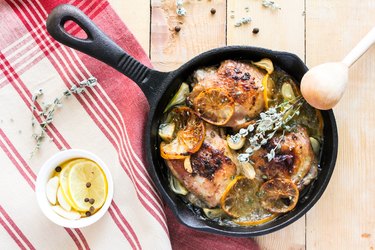
Marinating chicken adds moisture to the meat and can dramatically improve its flavor. Don't throw the leftovers out either — there's an easy method for turning marinade into a sauce.
Tip
Bring your chicken marinade to a boil, then reduce the heat and let it simmer until it reaches the desired to consistency. Then you can pour it on your chicken.
Video of the Day
Spice Up Your Chicken
Eating chicken can get boring quickly. It doesn't have much natural flavor of its own and can be quite dry. Different pieces of chicken have varying amounts of fat that adds moisture.
Video of the Day
Chicken thighs, for example, are higher in fat than chicken breast. According to the USDA, 4 ounces of chicken thighs has 18 grams of fat, compared to 4 grams for the same amount of chicken breast.
It's good to cut back on fat if you're on a diet and trying to eat fewer calories. Fat has 9 calories per gram, compared to 4 calories in protein and carbohydrates. However, it can be less appetizing to eat lean chicken breast. Marinades are perfect for adding flavor without many calories.
The complexity of your marinade can vary greatly. You can quickly throw salt, pepper and olive oil on your chicken and put it in a container in the refrigerator. Or, you can add lemon, soy sauce or vinegar for a more complex mixture. Spices like garlic, oregano, chili and ginger will further enhance the flavor.
Make a Marinade Reduction Sauce
Try our LIVESTRONG.com lemon chicken marinade recipe to give your dish a boost of chicken flavor. To make it, combine equal parts lemon and olive oil in a pan. Add pepper, rosemary, sage parsley, thyme and garlic. Make sure there's about half-cup of marinade per pound of meat.
The extra flavor should make the chicken taste better, but you can take things a step further by creating a marinade reduction sauce. Some marinades will boil better than others. If your concoction is too oily, it can splatter everywhere on your countertop while you cook it.
As it boils, you're turning marinade into a sauce. Be careful not to burn the contents of the sauce. Once it reached the desired consistency, remove it from heat and let it cool before drizzling on the meat. You can also reuse marinade by brushing it on chicken while grilling.
When you're cooking with marinade, safety is important. Any sauce sitting in a container with raw chicken might be contaminated with pathogens and cause food poisoning. Cooking your marinade to a boil should make it safe to eat.
Create Your Own Marinade
Depending on what you make your marinade from, your sauce may or may not be healthy. If you add sugar to the marinade, for example, your sauce will have more carbs from sugar. Soy sauce marinades are high in sodium. The USDA states that one tablespoon of a soy-based marinade contains 790 milligrams of sodium.
While store-bought marinades are easy to use, try creating your own. That way, you can choose what ingredients you use. Many marinades call for olive oil, which is high in fat and calories. As an alternative, you can use an acidic base like lemon juice or red wine.
A July 2018 study published in the Korean Journal For Food Science of Animal Resources studied the effects of acidic marinades on pork meat. The lemon juice in one of the marinades lowered the meat's pH. When pH levels are lower, it means that the meat is more acidic.
Meats with lower pH values are generally fresher, tender and moister, according to the above study. A November 2018 study published in the Journal of Food Safety explains that acids, such as sodium acetate, can even be used as preservatives. They keep the meat from spoiling but have a minimal impact on its flavor and texture.
- Korean Journal For Food Science of Animal Resources: How to Boil My Chicken Marinade & Use It as a Sauce
- U.S. Department of Agriculture: "Chicken Marinade"
- Academy of Nutrition and Dietetics: "How to Marinate Safely"
- U.S. Department of Agriculture Food Safety and Inspection Service: "Chicken From Farm to Table"
- Utah State University Food and Nutrition: "Marinating Meat Safely"
- U.S. Department of Agriculture: "How Many Calories Are in One Gram of Fat, Carbohydrate, or Protein?"
- U.S. Department of Agriculture: "Chicken Breast"
- U.S. Department of Agriculture: "Chicken Thighs"
- Journal of Food Safety: "Use of Organic Acids for Preservation and Safety of Traditional Meat Products"